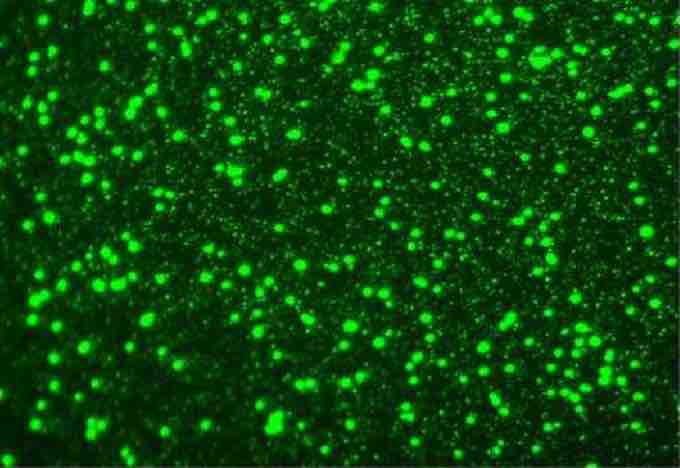Metagenomics is a relatively recent field of study that tries to understand the diversity—especially microbial—of the world around us. Through these studies it is now known that the number of viral particles and number of different viral species in almost every environment on Earth is immense. It is largely believed that viruses by species are the most numerous of any biological entity on earth. This is typified by the role of viruses in marine ecology. A teaspoon of seawater contains about one million viruses .

Viral diversity in seawater
The large green dots are bacteria while the smaller green dots are viral particles. This represents a fraction of the viral diversity seen in teaspoon of marine water.
Viruses are essential to the regulation of saltwater and freshwater ecosystems. Most of these viruses are bacteriophages, which are harmless to plants and animals. They infect and destroy the bacteria in aquatic microbial communities, comprising the most important mechanism of recycling carbon in the marine environment. The organic molecules released from the bacterial cells by the viruses stimulate fresh bacterial and algal growth.
Microorganisms constitute more than 90% of the biomass in the sea. It is estimated that viruses kill approximately 20% of this biomass each day, and that there are 15 times as many viruses in the oceans as there are bacteria and archaea. Viruses are the main agents responsible for the rapid destruction of harmful algal blooms, which often kill other marine life. The number of viruses in the oceans decreases further offshore and deeper into the water, where there are fewer host organisms. The effects of marine viruses are far-reaching; by increasing the amount of photosynthesis in the oceans, viruses are indirectly responsible for reducing the amount of carbon dioxide in the atmosphere by approximately 3 gigatonnes of carbon per year. Like any organism, marine mammals are susceptible to viral infections. In 1988 and 2002, thousands of harbor seals were killed in Europe by the phocine distemper virus. Many other viruses, including caliciviruses, herpesviruses, adenoviruses, and parvoviruses, circulate in marine mammal populations.
As mentioned, marine viruses are mostly bacteriophages, or phages. Phages are obligate intracellular parasites, meaning that they are able to reproduce only while infecting bacteria. Phages therefore are found only within environments that contain bacteria. Most environments contain bacteria, including our own bodies (called normal flora). Often these bacteria are found in large numbers. As a consequence, phages are found almost everywhere. As a rule of thumb, many phage biologists expect that phage population densities will exceed bacterial densities by a ratio of 10:1 or more (VBR or virus-to-bacterium ratio).
Estimates of bacterial numbers on Earth reach approximately 1030; consequently, there is an expectation that 1031 or more individual virus (mostly phage) particles exist, making phages the most numerous category of "organisms" on our planet. Bacteria (along with archaea) appear to be highly diverse and there are possibly millions of species. Phage-ecological interactions therefore are quantitatively vast, with huge numbers of interactions. Phage-ecological interactions are also qualitatively diverse: there are huge numbers of environment types, bacterial-host types, and also individual phage types.